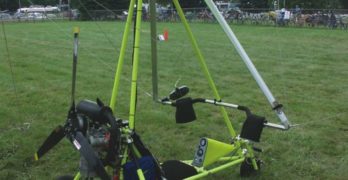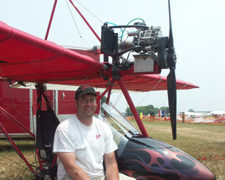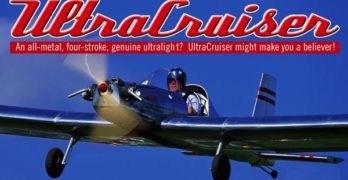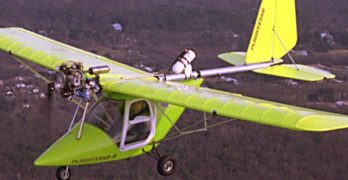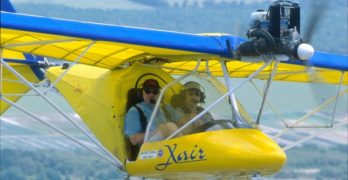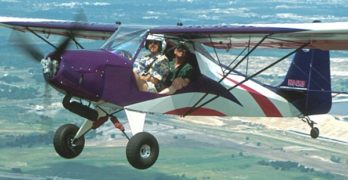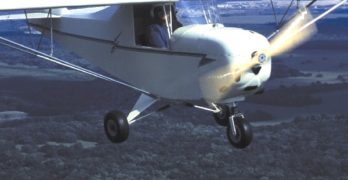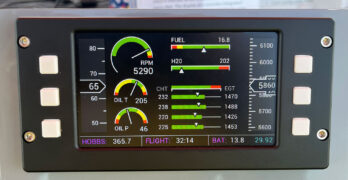After Rotax announced ASTM compliance for their lightweight 582 two-stroke engine, many American pilots celebrated. This lighter, simpler powerplant (compared to the 9-series engines) gave ultralight builders seeking SLSA certification more flexibility while significantly lowering cost for buyers. Now HKS enters the arena issuing a Statement of Compliance for the horizontally opposed, twin-cylinder, four-stroke, 60-hp 700E engine. HKS is lighter than four-cylinder engines and can save buyers several thousand dollars. American importer HPower has assisted at least 29 companies as they became HKS-powered, including such leading names as RANS, Quicksilver, Murphy, Earthstar, CGS, Titan, ASAP, and Flightstar. The Japanese company, HKS Aviation Co., Ltd., made their declaration on July 16, one month after the Rotax 582. Behind HKS Aviation is real depth in a 400-employee company active in high-performance auto components. I’ve flown a number of airplanes with this engine and have become converted to its smooth power.
Search Results for : Four stroke and ultralight
Not finding exactly what you expected? Try our advanced search option.
Select a manufacturer to go straight to all our content about that manufacturer.
Select an aircraft model to go straight to all our content about that model.
Part 103 Ultralights Shine
even in a Light-Sport Aircraft World.
Despite the intense focus on the FAA’s new Sport Pilot/Light-Sport Aircraft rule, EAA’s big summertime airshow brought the introduction of at least four intriguing, legitimate ultralights—aircraft that truly meet the 254-pound rule. Many observers believed LSA would sound the death knell for Part 103. I guess not!
Not only were new ultralights common, their diversity was broad. You could see a fixed-wing, a weight-shift trike, a powered parachute and a helicopter. As if seeking to prove the new rule won’t eliminate Part 103, these machines were proudly displayed by vendors who also supply larger, heavier models.
Skymaster Light Trike
One bright spot at EAA AirVenture was—literally—the glowing yellow Skymaster Light Trike. Excellent detailing kept viewers looking carefully.
Mike Lane is the man behind the project at Skymaster. He’s a hang-glider pilot looking for an easy way to launch in the flatlands of Wisconsin. His ultralight vehicle benefits from the supply bins at Skymaster powered parachutes, helping this prototype look production ready.
Innovating for Part 103 Ultralights
How can a Part 103 use a four-stroke engine? Well, you can elect the half-VW from Hummel…or you might try a rotary engine as seen at the 2005 Mid-Atlantic Fly-in. This innovative racing cart engine is being developed for Part 103 ultralight use (yes, to make the weight, with electric starter!) by Erik Pederson, the new president of Phantom Aeronautics. Impressively educated, Eric has a BS in Aero Engineering plus an MS and PhD in Mechanical Engineering. Watch for a test report when Erik is satisfied with the performance.
Four-Stroke Engines for Ultralights
Ultralights have long been defined by their two-stroke engines. Rotax and other brands refined the two-stroke for aircraft use, and today’s two-stroke powerplants deserve their popularity. In the important power-to-weight ratio, two-strokes are hard to beat. Their cost is low, their overhauls cheap; these humble powerplants have lifted many a pilot into the air for many hours.
But despite the improvements, despite plentiful businesses to help you maintain your two-stroke engine, and despite a good performance record, two-strokes are still seen as inferior to four-strokes by many aviators.
Add to these impressions the regulatory changes many see as inevitable. The blue-smoking two-stroke (even when optimized) presents environmental problems for snowmobiles, watercraft and gas-powered lawn tools. Two-stroke days are numbered—not because of efficiencies, but because of ecological concerns and political decisions.
Hail the Four-Stroke
General aviation people say, “Well, of course four stroke is better.” But that’s the only kind of engine most of them know, and their aircraft weigh enough to accommodate heavier powerplants.
All-metal, Four-stroke, Genuine Ultralight
The new light-sport aircraft (LSA) category will soon be a reality. While a best guess is that FAA’s newest rules could be announced at EAA AirVenture Oshkosh later this month, it may happen later in the year. Whenever it happens, and like many others watching closely, I hope this new concept arrives swiftly with its promise of interesting aircraft at affordable prices.
As important as LSA may be, however, the proposed new the rule doesn’t affect other enjoyable flying machines. Aircraft built under the amateur-built (51-percent) rule will continue to be a major factor. Many EAA members are building under this rule, and these aircraft will continue to offer wide choices, performance beyond that of many general aviation aircraft, and the pride of craftsmanship. LSA also leaves room for Part 103 ultralights to continue and grow. While some industry leaders see little demand for single-seat aircraft powered by small engines-and it is true that they do not make up a majority of machines-neither, however, will they disappear.
The First Two Ultralights with the New HKS Engine
It isn’t often I can do “scouting party” duty on engines. Powerplants aren’t normally my focus. They
are a necessity for flight, but they aren’t my main attraction. A great many pilots I’ve met appear to be just the reverse: They are extremely interested in engines.
I enjoyed the chance to fly behind the first European and first American installations of the new 60-hp HKS 700E 4-stroke from Japan’s HKS Company Ltd. With that in mind, this pilot’s report is rather different. We’ll look at this new engine on two different aircraft.
As all Ultralight Flying! readers know, Rotax has enjoyed great success for more than a decade as an ultralight engine supplier. After dominating the 2-stroke market, Rotax introduced the 81-hp Rotax 912 4-stroke, which has become a popular powerplant choice for sport aviation aircraft.
Is a 4-Stroke Better?
All 4-stroke engine manufacturers trumpet their advantages over 2-strokes: lower fuel consumption, quieter operation, longer time between overhaul, and reliability.
Xair Standard and F Models
he Xair hardly looks like a Weedhopper anymore. And its French-based producer, Randkar, may no longer care to associate with the pioneering design (though they surely wouldn’t mind selling 4,000 units like the Weedhopper). Indeed, the machine is now so different, the heritage barely reveals itself.
Today, it may take a stretch of imagination to see the Weedhopper under the Xair’s fancy new coverings. To try, let your mind’s eye take away the entire cockpit assembly and the aft fairing. What you’re left with does begin to look like a Weedhopper. The swept wing with its long chord, the simple, angular tail… it’s clearly a derivative of John Chotia’s Weedhopper.*
Global Contender
Created in America, the Weedhopper migrated to Europe (where more than one company picked up on the simple ultralight). One of those companies is France’s Randkar, which produces the Xair. It is built by an Indian company, Raj Hamsa, and returned to American soil by its U.S.
Sky Raider Goes Tandem
Part-Time 2-Seater
Like the Kolb FireStar II, the Sky Raider II has a second seat for occasional use – but not for flight instruction. After flying with 165-pound Grant Rappe – a long-time Sky Raider pilot – as my volunteer rear seat passenger, I feel that two big fellows won’t fit. And even with small rear-seat occupants, you probably won’t want to fly for too long. Nonetheless, if you want a ride-along jump seat for occasional use, but you truly prefer single-seat handling and you don’t want to pay a bundle extra for the second seat and dual controls, the Sky Raider II might be for you.
Admittedly you have other choices in this vein. French trike maker Air Création addressed it with their Buggy. Here’s a 2-seat aircraft, which the manufacturer says is mainly intended for single-place operation. The New Kolb Aircraft Company has two models that can do this (the FireStar II and Slingshot II) and of course, the very similar Rocky Mountain Wings Ridge Runner Model II also works much like a Sky Raider II.
Carlson Sparrow Single-Place Ultralight Aircraft
Carlson’s White-Throated Sparrow 503
General aviation pilots who visit the ultralight area at an air show often regard some aircraft with apprehension, wondering if these different-looking machines are indeed actually airworthy.
In the early days of ultralight aircraft, many designs were in fact of questionable quality. These days, however, the aircraft you see on display generally are solid machines with admirable safety records.
It’s a little confusing at first, but not all ultralights are officially Ultralights. Some weigh just a little too much — a product of trying to satisfy customers by adding larger engines and other features. Some fly a little too fast or carry a little too much fuel. It doesn’t take much to barely miss the tight FAR Part 103 regs.
Fortunately that doesn’t matter much to Flyer readers, as the majority of us have private pilot certificates and our medicals are current. We can simply put an N-number on our ultralight-like aircraft and fly it as we would any certified airplane.
Wapsi Aero Debuts Multifunction Display at AirVenture
If you are piloting an ultralight or light plane VFR, you really don’t need an artificial horizon or a heading indicator. But you do need airspeed and altitude, and it’d be nice to have that available in a compact, clear, modern package. Even better, you’d like to make sure everything is happy in the power barn, as well as your airspeed and altitude.
In the spirit of providing everything you need and nothing you don’t, Wapsi Aero brought a bright and affordable electronic flight instrument that has generated quite a bit of buzz at AirVenture’s ultralight field. The rectangular instrument provides graphical engine data mid screen with airspeed and altitude in legible tape readouts on each side—combining a partial EFIS with an engine monitor. The screen is bright and easily readable, even in direct sunlight. The instrument also provides Hobbs and flight timers as well as battery voltage.
Even better, the Wapsi device is designed to fit into the same hole that may currently house a GRT EIS engine monitor—of which there have to be thousands in the field.
- « Previous Page
- 1
- 2
- 3
- 4
- 5
- 6
- …
- 17
- Next Page »



